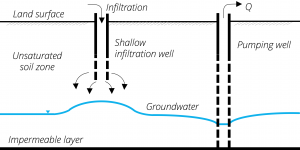
The infiltration through shallow wells, shafts or pits is usually practiced to recharge a phreatic aquifer where spreading methods cannot be applied because of the existence of a low permeability surface layers. Often abandoned wells or pits are used that had previously fallen dry. The water fed into the structure will slowly replenish the aquifer. It is a cost effective method because recharge is governed by gravity flow only.
| Typical system capacity scale | Village – Town (≈104 m3/year – ≈106m3/year). |
| Geology | Unconfined aquifers composed of unconsolidated rocks where a surface low permeability layer is present. |
| Topography | Flat terrains may be associated with lower erosion and less clogging by sediments. |
| Soils | Not relevant for this kind of technology. |
| Water source | River water, lake water, treated wastewater, storm water. |
| Pre-treatment | Water treatment is recommended to prevent clogging and to comply with local groundwater regulations. |
| MAR main objective | Recover groundwater levels. |
| Relative cost | Low-Medium (existing infrastructure may be used to reduce costs). |
Advantages and disadvantages of the system (adapted from IGRAC, 2007):
Advantages
- Existing facilities may be used to reduce costs of building new infrastructure.
- In the case of shallow wells, water recovery through the same structure reduces clogging.
Limitations
- High water quality demands of source water.
Case studies
REFERENCES
- IGRAC. (2007). Artificial Recharge of Groundwater in the World.
- DEMEAU. (2014). Characterization of European managed aquifer recharge (MAR) sites – Analysis.
